M. Moshiur Rahman1, M. A. H. Bhuiyan2, Asaduzzaman1
1Department of Physics, Jahangirnagar University
2Institute of Nuclear Science and Technology, AERE, Savar, Dhaka
Correspondence to: M. Moshiur Rahman, Department of Physics, Jahangirnagar University.
| Email: |  |
Copyright © 2014 Scientific & Academic Publishing. All Rights Reserved.
Abstract
An experiment was carried out to measure the radiation dose rate in and around the Central Radioactive Waste Processing and Storage Facility (CWPSF). Among the total of 107 points, the measured values for beta ray varied from 0.24 to 22.08 Bq/cm2. Remarkable beta flux was noticed in Sealed Radioactive Source Storage (SRSS), Interim Storage Room (ISR), Calibration Source Room (CSR) and some part of outer surface wall of CWPSF. Gamma dose rates measured at various points inside, outside and roof of the CWPSF varied from 0.11 to 39.20 μSv/h. Substantial gamma dose rates were found in SRSS, ISR, CSR and outer surface of the wall nearby SRSS. The highest gamma dose rate was recorded 39.20 μSv/h. Probably, because of very few neutron sources inside of SRSS, neutron dose rates were found very low in an interval from 0 to 0.0197 μSv/h. This experiment finally yielded a meaningful verification on area classification for radiation work in accordance to the IAEA Safety Series, hence giving a potential outcome for radiation protection and safety practices in CWPSF. In the contemporary approach of nuclear practices the measurement of external dose rates plays a substantial importance in protection and safety from the ionizing radiation.
Keywords:
CWPSF, mSv, μSv/h, ALARA, SSDL, LET, SCA and LAD etc
Cite this paper: M. Moshiur Rahman, M. A. H. Bhuiyan, Asaduzzaman, Assessment of Radiation Dose from Radioactive Waste in Bangladesh and Probable Impact on Health, Journal of Nuclear and Particle Physics, Vol. 4 No. 2, 2014, pp. 79-86. doi: 10.5923/j.jnpp.20140402.05.
1. Introduction
With the ever-increasing public health problem associated with radiation, it has been renewed interest about the study of the rising level of radioactivity and its probable effect on human health. Moreover, now a days, radio-isotopes are used in various field which may cause of environmental contamination due to radiation. Radio-isotopes are used in Smoke Detectors, Agriculture, Food Irradiation, Irradiation in Pest Control, Archaeological Dating and Medical purposes. Meta-stable isotopes such as 99mTc, 18F, 131I are used for imaging of bone, radio-isotopic scintigraphy and for the dynamic study of kidney, liver etc. 60Co, 137Cs etc are used for the treatment of malignancy and cancerous cell. Radio isotopes are also used for food irradiation to sterilize & pest control [1]. All these activities increase the environmental radioactivity level with consequent increase of exposure to the public.Bangladesh Atomic Energy commission set up its first 3 MW TRIGA MARK-II research reactor at the AERE, Saver in 1986. The reactor becomes a source of intense ionizing radiation during its operations [2, 3, 4, 5]. This may significantly increase the open field gamma ray. Central Radioactive Waste Processing and Storage Facility (CWPSF) has been established at AERE, Savar in order to manage the radioactive waste produced throughout the country. Since the wastes produced throughout the country are stored here, the rising level of radioactivity surroundings the CWPSF will indicate the probable health risk associated with radiation throughout the country. It is my great intention considering the real versus the perceived risk of radiation exposures, to aware of the acute effects of large radiation exposures and to determine whether the radiation one is handling presents an actual risk, or does not and how it is correlated with the health problem. The experiments were carried out to detect the radiation type and measurement of radiation exposure to general public and radiological workers. The works will have a contribution to compare the present radiation exposure rate with future radiation exposure rate which measure the rising level of radiation exposure rate. This will be helpful to detect either the environment is hazardous or not, to find the relationship between epidemic of radiation exposure and cancer and its prevention purposes.
2. Acquaintance to CWPSF
With the rapid increase in nuclear applications in health, industry, and agriculture sectors as well as nuclear research conducted at a 3-MW TRIGA Mark-II research reactor and radiopharmaceutical production at Radioisotope Production Division (RIPD) etc., a considerable amount of low and intermediate level radioactive waste (LILW) has been generated in Bangladesh. In order to safe management of LILW, the Bangladesh Atomic Energy Commission (BAEC) has built a Central Radioactive Waste Processing and Storage Facility (CWPSF). This facility has been built according to a typical design that was suggested by the International Atomic Energy Agency (IAEA) of the United Nation (UN) and got technical assistantship with the international technical collaborative project [6].
3. Materials and Methods
Radiation detection and measurement were performed through a set of measuring instrument [7, 8, 9, 10]. All measuring equipments were calibrated in the Secondary Standard Dosimetry Laboratory (SSDL) of INST. For calibration process the official standard protocol followed by SSDL was adapted from the IAEA safety series. Levels of the radiation hazard were assessed by performing dose rate surveys and contamination surveys. Dose rate meters measure the operational quantity of ambient dose equivalent rate. These measurements give a good approximation of the effective dose rate to our bodies.
4. Experimental Data
Dose rates were measured at different operational compartments inside, outside and roof surface of the CWPSF. During measurement inside the facility, compartments that are currently involved in raising the dose rate and radioactive material handling are grouped separately and graphically represented below. 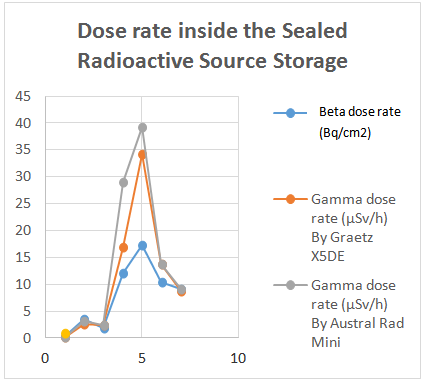 | Figure 1. Dose rate inside the Sealed Radioactive Source Storage |
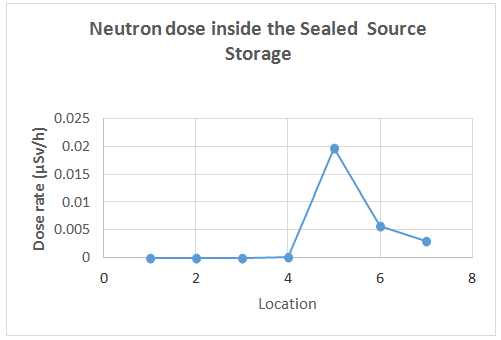 | Figure 2. Neutron dose inside the Sealed Source Storage |
 | Figure 3. β and γ dose inside the Interim Storage (ISR) |
 | Figure 4. Inside the Calibration Source Room |
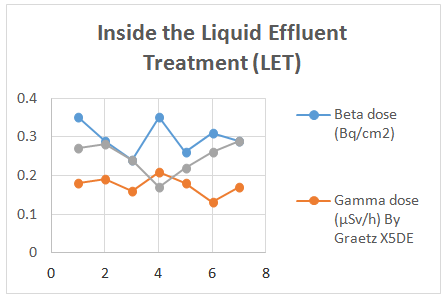 | Figure 5. Inside the Liquid Effluent Treatment (LET) |
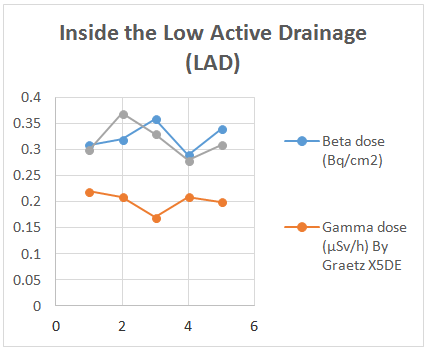 | Figure 6. Inside the Low Active Drainage (LAD) |
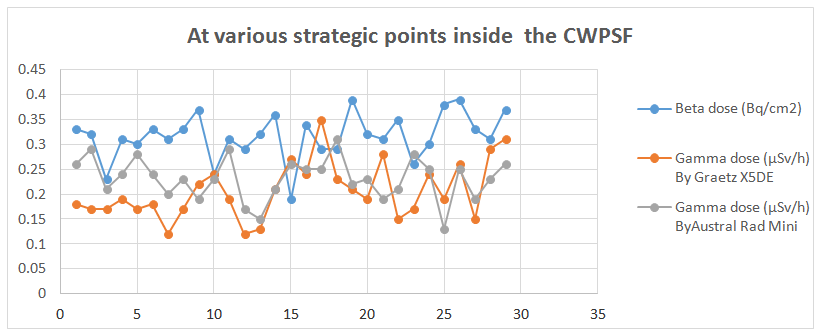 | Figure 7. At various strategic points inside the CWPSF |
 | Figure 8. At various strategic points outside the CWPSF |
 | Figure 9. At various strategic points at roof surface of the CWPSF |
5. Standard Reference Values and Limits
Occupational dose limits and public dose limits apply to exposures resulting from practices, and exclude medical exposures and natural background. The annual occupational dose limit for effective dose is 20 mSv with a further provision that it should not exceed 50 mSv in any single year. The annual public dose limit is 1 mSv, but in special circumstances a higher public dose could be allowed as long as the average over five years does not exceed 1 mSv per year. The current dose limits recommended in ICRP Publication 60 are summarized in table 1 and 2. Table 1. Permissible dose for occupational radiation workers [11]
 |
| |
|
Table 2. Area Classification with Respect to Annual Dose [11,12]
 |
| |
|
6. Result and Discussion
An important part of a radiation protection program of a nuclear facility is the monitoring of areas where radiation hazards may exist. Levels of the radiation hazard can be assessed by performing dose rate surveys (for the external hazard) and contamination surveys (for the internal hazard). Alpha particles have only a very short range in air (a few cm), and are not considered an external radiation hazard since they cann’t penetrate the outer layers of the skin, therefore it was not measured. On the other hand, like gamma rays, neutrons are also highly penetrating. They give energy to the body as they are scattered in body tissues. Neutrons are an important external radiation hazard which requires careful control. In addition to regulatory and management requirements, radiological control is also necessary at the operational level to ensure safe practices in the workplace, as well to protect the general individuals and the environment. With these practical considerations, Beta, gamma and neutron dose rates of various operational units in CWPSF were measured to estimate the rising level of radiation due to its operational activities. All measuring equipment’s were calibrated in the Secondary Standard Dosimetry Laboratory (SSDL) of INST. The error were always below 5% during the calibration. So experimental sensitivity may be reliable.
7. Dose Rate inside the CWPSF
Average Dose Rates, inside Sealed Radioactive Source Storage (SRSS), Interim Storage Room (ISR), Calibration Source Room (CSR), Liquid Effluent Treatment (LET) Enclosure, Low Active Drainage and Sorting and Compaction Area (SCA) of CWPSF were found with the values that are tabulated in the following data table-3 and are shown graphically in fig.10-12.Table 3. Dose Rates inside CWPSF
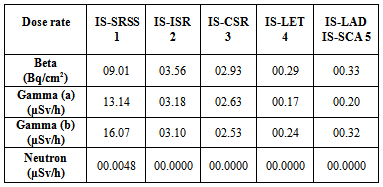 |
| |
|
 | Figure 10. Beta dose rate inside the operational enclosures |
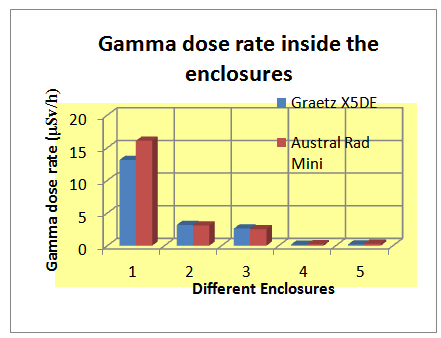 | Figure 11. Gamma dose rate inside the enclosures |
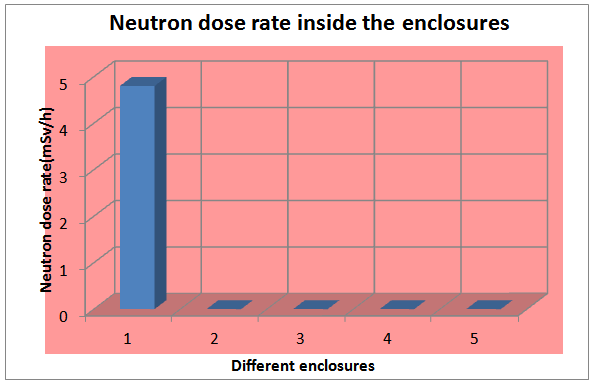 | Figure 12. Neutron dose rate inside the enclosures |
These are the main operational compartments inside CWPSF which are associated with either radiation work to producing the dose rate or accumulation of substantial radioactive material there in. Interpreting the data obtained from Result 3.1, the gamma dose rates measurement values lead to classify the area of CWPSF as in table 4. Table 4. Classification of area of CWPSF
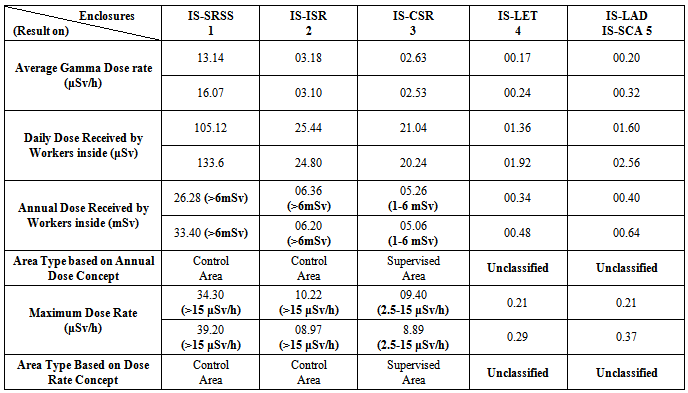 |
| |
|
In comparison with the reference standard values, it is clear that SRSS and ISR fall in the category of control area while the CSR falls in supervised area. LET, SCA and LAD till possible to remain unclassified. Again we can say due to the substantial accumulation of radioactive sources in the SRSS and storing of radioactive wastes in ISR keep them in the category of control area, hence protective actions are necessary to work in these zones. Radiation workers in SRSS and ISR will receive an effective dose far above the annual dose limit (20 mSv) if they work for their full occupancy (e.g. 8 hour/day round the 50 weeks year concept). There are only few neutron sources at some specified points of measurement; hence the dose rate is considerable for that partial zone only.
8. Dose Rate on the Outer Surface of the CWPSF
Here, once again the same trend was noticed, where most of the measuring points have considerably low beta dose rate except some points outside the SRSS room, specially the points, which are closure to the sources stored inside. The highest value of beta flux rate was found 24 Bq/cm2. There are some measuring points regarding gamma dose, which were found with values up to the highest 22 μSv/h. These are above the restricted standard value, therefore special care and protective action has to be taken. Hopefully these are free from public access.
9. Dose Rate on the Roof of CWPSF
As it was expected the beta and gamma dose rates for the points at roof surface were considerably low in magnitude. Except, couple of measuring points on the SRSS roof surface, which had slightly higher value compared to the background level, all other points were free of any measurable dose rate. Beta flux varied from 0.31 to 0.76 Bq/cm2 where as gamma dose rate from 0.13 to 0.39 μSv/h.
10. Conclusions
Beta, gamma and neutron dose rates of various operational units in CWPSF were measured to estimate the rising level of radiation due to its operational activities. Wherever slightly elevated dose rates were noted, the measured values to suggest for inter comparison; national and international regulations and consideration should be given to reduce the dose rate in accordance with the ALARA principle. The measured values of radiation dose in SRSS and ISR i.e. where the radio-waste are stored are 26.28mSv and 6.20mSv respectively and classified as control area; CSR point exhibit the annual dose rate of 5.06mSv and marked as supervised area. These areas are free from public access. The points somewhere exceeding the regulatory expectation of 20mSv for occupational workers whiles most others are with the normal operational level that is below the permissible limit of 1 for public. A number of safety precautions were practiced during performing the dose rate survey. Electronic Pocket Dosimeter showed a total of 5.2 𝜇Sv that was received by the personnel involved in this work. In deed this received dose is far below than, even to the public dose restriction limit 1 mSv/year.
References
| [1] | http://www.chem.duke.edu. |
| [2] | M. A. Malek, K. J. A. Chisty, M. M. Rahman, Radiological Concentration Distribution of 131I, 132I, 133I, 134I, and 135I Due to a Hypothetical Accident of TRIGA Mark-II Research Reactor, Journal of Modern Physics, Vol.3 No.10, October 2012. PP. 1572-1585. |
| [3] | M.A. Zulquarnain, M.M. Haque, M.A. Salam, M.S. Islam, P.K. Saha, M.A. Sarder, A. Haque, M.A.M. Soner, M.M. Uddin, M.M. Rahman, I. Kamal, M.N. Islam, S.M. Hossain; Int. J. of Nuclear Energy Science and Technology > 2009 Vol.4, No.4 > pp.299 – 312. |
| [4] | HAQUE, M. M., ZULQUARNAIN, M. A., SALAM, M. A. www-pub.iaea.org/.../CN-82-35. |
| [5] | Debasish Paul,http://www.iaea.org/NuclearPower/Downloads/Infrastructure/meetings/2012-03-20-23-TM-Vienna/25. |
| [6] | INTERNATIONAL ATOMIC ENERGY AGENCY, reference design for a centralized waste processing and storage facility, TECDOC-776, IAEA, Vienna (1994). |
| [7] | Asaduzzama, M.S. Thesis, 2010, Department of Physics, JU, P35 – 70. |
| [8] | "Radiation Measurement." Encyclopædia Britannica Online. 2011. Web. 04 Mar.2011.. |
| [9] | Glenn F. Knoll - John Wiley & Sons (2010.08.16) Radiation Detection and Measurement. |
| [10] | Alan Martin and Samuel A Harbison, “An Introduction to Radiation Production”, Chapter 7: Radiation Detection and Measurement. P-74. |
| [11] | Nuclear Safety and Radiation Control regulation 1997, BAEC, Bangladesh. |
| [12] | Safety Standards “International Basic Safety Standards for Protection Against Ionizing Radiation and for the Safety of Radiation Sources”, IAEA Safety Series 115. |













 Abstract
Abstract Reference
Reference Full-Text PDF
Full-Text PDF Full-text HTML
Full-text HTML


